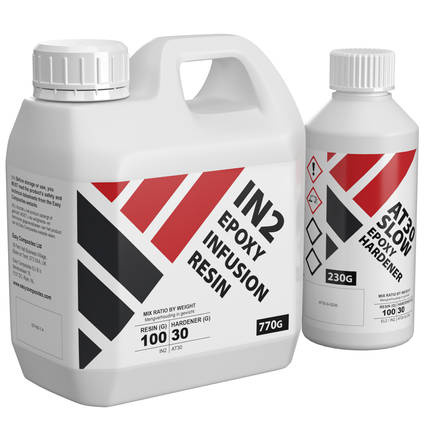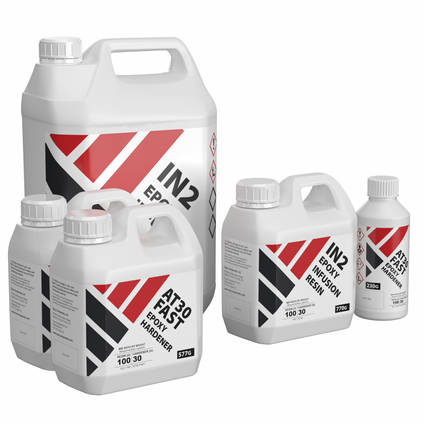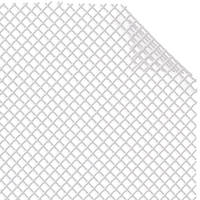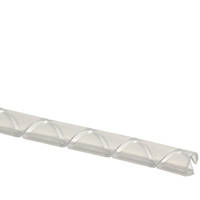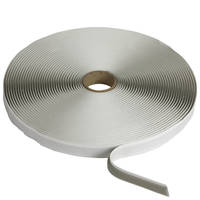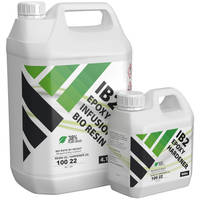Heb je hulp of advies nodig?+44 (0)1782 454499
Downloads (3)
Dit is een chemisch product. Voor opslag of gebruik moet u de bijgevoegde veiligheids- en technische informatiebladen downloaden en lezen.
| Veiligheidsinformatieblad (SDS) - NL | ||
| Veiligheidsinformatieblad (SDS) - NL | ||
| Technisch gegevensblad (TDS) |
Specificatie
Geharde Echanische Eigenschappen
| Max. Onderhoudstemperatuur | 73 | °C |
|---|---|---|
| Druksterkte | 80 - 100 | MPa |
| Hardheid | 86 (Hard) | Kust D |
| Flexibiliteit | Hard/stijf | |
| Treksterkte | 68.5 - 76 | MPa |
| Buigsterkte | 110 - 120 | MPa |
| Buigmodulus | 3.1 - 3.5 | GPa |
| Rek bij Breuk | 6.0 - 8.0 | % |
| Tg Begin (DMA) | 92 - 98 | °C |
Productgegevens
| Kleur | Duidelijk | |
|---|---|---|
| Chemie / Materiaal | Epoxy | |
| Viscositeit | 325 | mPa.s |
| UV-bestendigheid | Zeer goed | |
| Merk | Easy Composites | |
| Houdbaarheid | 12 | Maanden |
Levensduur Pot en Uithardingstijden
| Levensduur Pot (Normaal) | 120 - 150 | minuten |
|---|---|---|
| Initiële Uithardingstijd | 24 | Uur |
Algemene Eigenschappen
| Brutogewicht | 1.121 | kg |
|---|
Verzendinformatie
Beperkingen
Dit product is geclassificeerd als gevaarlijke goederen voor transport.
Het kan worden verzonden naar alle landen op het vasteland van de EU, Ierland, de Balearen, Corsica, Sicilië en Sardinië.
Helaas kunnen we op dit moment geen gevaarlijke goederen verzenden naar Cyprus, Malta, de Canarische Eilanden, Ceuta, Melilla, Jan Mayan en Spitsbergen.
Zie onze pagina met leveringsinformatie voor volledige informatie over de verzending van gevaarlijke goederen.
Verpakkingsgrootte
Er zijn geen beperkingen op de pakketgrootte of toeslagen voor dit product.
Verzendkosten
Om de bezorgkosten van dit artikel naar uw adres te achterhalen, voegt u het toe aan uw winkelwagen en gebruikt u vervolgens de directe verzendkosten calculator op de winkelwagenpagina.
IN2 Epoxy Infusiehars
- EP-IN2-S-1
Gevaarlijk
- 5/5 Gemiddelde beoordeling
IN2 is de industriestandaard epoxy infusiehars. Zijn lage viscositeit, heldere UV-stabiele uiterlijk, uitstekende mechanische eigenschappen en variabele verhardingssnelheid maken het de eerste keuze voor infusiehars met hoge prestaties, vooral in combinatie met hoogwaardige versterkingen zoals koolstofvezel en Kevlar®.
Wordt verkocht als kit (hars en verharder). Online te koop met een keuze uit FAST of SLOW verharder in 1kg en 5kg kits.
PRODUCTVERSIES
Kit Maat
Snelheid
BESCHIKBAARHEID:Meer dan 10 beschikbaarvoor onmiddellijke verzending
We zijn niet te verslaan op prijs!
Als u denkt dat u elders een gelijkwaardig product goedkoper kunt kopen, neem dan contact met ons op om uw wensen te bespreken.
Deze hoogwaardige epoxyhars is speciaal geformuleerd voor gebruik bij de productie van harsinfusiecomposieten.
Als infusie-epoxy heeft het een ultralage viscositeit waardoor het snel door een reeks versterkingen kan infuseren. De uitstekende mechanische sterkte maakt het ideaal voor gebruik met hoogwaardige versterkingen zoals koolstofvezel en aramides zoals Kevlar.
SNELLE en TRAGE verharders
Onze IN2 Infusion Resin is verkrijgbaar met een keuze uit twee verhardingssnelheden; 'FAST' die een pot-life heeft van 9-14 minuten en ontvormbaar is in ongeveer 8 uur en 'SLOW' die een pot-life heeft van 80-100 minuten en ontvormbaar is in ongeveer 24 uur. Standaard adviseren we IN2 infusiehars te gebruiken met de SLOW verharder, vooral voor grotere infusieprojecten. Voor kleine projecten waarbij je zeker bent van de infusietijd, vermindert het gebruik van de SNELLE verharder de ontvormtijd aanzienlijk. Kies de gewenste verharder snelheid uit de drop-down lijst bovenaan de pagina.
In aanvulling op de opties van FAST of SLOW verharder, hebben we onlangs de optie toegevoegd om de verharders te splitsen en de helft FAST en de helft SLOW op de 1kg en 5kg kitmaten te hebben. Als je hiervoor kiest, worden de verharders geleverd als één verpakking FAST en één verpakking SLOW in de juiste verhouding tot de harsset.
Helaas kunnen we geen gemengde verhardersnelheden aanbieden op de 500g of 32,5kg kitformaten.
FAST en SLOW verharders kunnen gemengd worden om pot-life en ontvormtijden te verkrijgen die overal tussen de specificaties liggen. Je moet echter nog steeds de juiste verhouding hars/verharder aanhouden voor een goede uitharding.
Typisch Gebruik
Dit is een hoogwaardige epoxyhars met een lage viscositeit, speciaal geformuleerd voor gebruik bij de productie van harsinfusiecomposieten. De hars hardt uit tot een heldere afwerking.
Dit is dezelfde epoxy-infusiehars die wordt meegeleverd met onze Resin Infusion Complete Starter Kit.
We hebben ook een biologische versie van onze infusiehars die de inhoud op basis van fossiele brandstoffen vervangt door een biologisch afgeleid alternatief. Je vindt het hier: IB2 Epoxy infusie Bio Hars
Verdere informatie
Potlife beheren tijdens harsinfusie
Tijdens een infusie kun je de kans op 'geleren' van de hars in de pot verminderen door kleine hoeveelheden per keer te mengen en de harskan bij te vullen terwijl de hars in het laminaat wordt getrokken. Als de hars eenmaal in het laminaat zit, is de kans veel kleiner dat het gaat exothermen en geleren voordat je dat wilt.
Compatibiliteitsinformatie - Wat Wel en Niet Moet Doen
Hoewel dit zeker geen volledige lijst is, zijn de onderstaande matrijsmaterialen, pigmenten en additieven allemaal getest en staan ze bekend om hun goede werking met IN2.
Compatibele mallen
- Uni-Mould systeem
- Epoxy Tooling Gelcoat
- Mallen op basis van epoxygelcoat
- Polypropyleen en polyethyleen plaat
- Aluminium
- Gehard glas (bijv. productie van vlakke platen)
Compatibele Pigmenten
- Epoxy kleurpigment * (voor levendige dekkende kleuren)
- Doorschijnend kleurpigment * (voor minder levendige dekkende kleuren)
Compatibele vulstoffen
- Alle droge vulpoeders
- GC50 aangebracht op maloppervlak
* Bij sterk gekleurde laminaten, zoals koolstofvezel, kan de onderliggende kleur van de stof nog steeds door de gepigmenteerde hars heen te zien zijn. Dit is vooral het geval met infusiehars omdat de aard van de harsinfusie zodanig is dat er een veel dunnere harslaag over het onderliggende laminaat ligt in vergelijking met andere verwerkingsmethoden.
Belangrijke Verwerkingsinformatie
- Gebruiksgemak: Geschikt voor professioneel en hobbygebruik (volg het veiligheidsinformatieblad).
- Geur: IN2 is bijna reukloos.
- Veiligheidsmaatregelen: Draag handschoenen en een veiligheidsbril en werk in een goed geventileerde ruimte. Lees voor gebruik altijd het veiligheidsinformatieblad (MSDS).
- Omgevingsomstandigheden: Kan gebruikt worden van 15 tot 30°C, hoewel de pot-life en uithardingstijd aanzienlijk beïnvloed worden. Aanbevolen bij een omgevingstemperatuur van 20-25°C.
- Ontgassen: In de meeste gevallen niet nodig. Gewoon mengen en gebruiken. Als je overtollige lucht hebt ingesloten door het mengen, laat de harspot dan 5 minuten staan zodat de luchtbellen kunnen ontsnappen.
- Mengverhouding: Meng 'Hars' en 'AT30 Verharder' 100:30 in gewicht. Gebruik een digitale weegschaal.
- Mengen: Meng grondig met de hand gedurende ongeveer 2 minuten. Probeer overmatige luchtinsluiting te vermijden.
- Potleven: SNELLE VERHARDING 9-14 minuten. TRAGE uitharder 80-100 minuten. Gebruik je hars vóór deze tijd.
- Batchgrootte: Meng batches die passen bij de snelheid van de verharder, zodat de hars in de pot niet begint uit te harden of te exothermen terwijl de infusie bezig is.
- Exotherm (oververhitting): Hars wordt warm terwijl het uithardt. Meng in kleine batches en gebruik snel. Gemengde hars in een pot raakt snel oververhit (exotherm) en kan gaan roken/ontbranden. Laat gemengde hars nooit onbeheerd achter.
- Uithardingstijd/uitvloeiing: Bij 25°C kun je een typische uithardingstijd verwachten van 6-8 uur voor de FAST & 18-24 uur voor de SLOW AT30 verharders.
- Pigmenten en vulstoffen: Een breed scala aan pigmenten en vulstoffen kan worden toegevoegd om de eigenschappen en het uiterlijk van hars te veranderen.
Deze hoogwaardige epoxyhars is speciaal geformuleerd voor gebruik bij de productie van harsinfusiecomposieten.
Als infusie-epoxy heeft het een ultralage viscositeit waardoor het snel door een reeks versterkingen kan infuseren. De uitstekende mechanische sterkte maakt het ideaal voor gebruik met hoogwaardige versterkingen zoals koolstofvezel en aramides zoals Kevlar.
SNELLE en TRAGE verharders
Onze IN2 Infusion Resin is verkrijgbaar met een keuze uit twee verhardingssnelheden; 'FAST' die een pot-life heeft van 9-14 minuten en ontvormbaar is in ongeveer 8 uur en 'SLOW' die een pot-life heeft van 80-100 minuten en ontvormbaar is in ongeveer 24 uur. Standaard adviseren we IN2 infusiehars te gebruiken met de SLOW verharder, vooral voor grotere infusieprojecten. Voor kleine projecten waarbij je zeker bent van de infusietijd, vermindert het gebruik van de SNELLE verharder de ontvormtijd aanzienlijk. Kies de gewenste verharder snelheid uit de drop-down lijst bovenaan de pagina.
In aanvulling op de opties van FAST of SLOW verharder, hebben we onlangs de optie toegevoegd om de verharders te splitsen en de helft FAST en de helft SLOW op de 1kg en 5kg kitmaten te hebben. Als je hiervoor kiest, worden de verharders geleverd als één verpakking FAST en één verpakking SLOW in de juiste verhouding tot de harsset.
Helaas kunnen we geen gemengde verhardersnelheden aanbieden op de 500g of 32,5kg kitformaten.
FAST en SLOW verharders kunnen gemengd worden om pot-life en ontvormtijden te verkrijgen die overal tussen de specificaties liggen. Je moet echter nog steeds de juiste verhouding hars/verharder aanhouden voor een goede uitharding.
Typisch Gebruik
Dit is een hoogwaardige epoxyhars met een lage viscositeit, speciaal geformuleerd voor gebruik bij de productie van harsinfusiecomposieten. De hars hardt uit tot een heldere afwerking.
Dit is dezelfde epoxy-infusiehars die wordt meegeleverd met onze Resin Infusion Complete Starter Kit.
We hebben ook een biologische versie van onze infusiehars die de inhoud op basis van fossiele brandstoffen vervangt door een biologisch afgeleid alternatief. Je vindt het hier: IB2 Epoxy infusie Bio Hars
Verdere informatie
Potlife beheren tijdens harsinfusie
Tijdens een infusie kun je de kans op 'geleren' van de hars in de pot verminderen door kleine hoeveelheden per keer te mengen en de harskan bij te vullen terwijl de hars in het laminaat wordt getrokken. Als de hars eenmaal in het laminaat zit, is de kans veel kleiner dat het gaat exothermen en geleren voordat je dat wilt.
Compatibiliteitsinformatie - Wat Wel en Niet Moet Doen
Hoewel dit zeker geen volledige lijst is, zijn de onderstaande matrijsmaterialen, pigmenten en additieven allemaal getest en staan ze bekend om hun goede werking met IN2.
Compatibele mallen
- Uni-Mould systeem
- Epoxy Tooling Gelcoat
- Mallen op basis van epoxygelcoat
- Polypropyleen en polyethyleen plaat
- Aluminium
- Gehard glas (bijv. productie van vlakke platen)
Compatibele Pigmenten
- Epoxy kleurpigment * (voor levendige dekkende kleuren)
- Doorschijnend kleurpigment * (voor minder levendige dekkende kleuren)
Compatibele vulstoffen
- Alle droge vulpoeders
- GC50 aangebracht op maloppervlak
* Bij sterk gekleurde laminaten, zoals koolstofvezel, kan de onderliggende kleur van de stof nog steeds door de gepigmenteerde hars heen te zien zijn. Dit is vooral het geval met infusiehars omdat de aard van de harsinfusie zodanig is dat er een veel dunnere harslaag over het onderliggende laminaat ligt in vergelijking met andere verwerkingsmethoden.
Belangrijke Verwerkingsinformatie
- Gebruiksgemak: Geschikt voor professioneel en hobbygebruik (volg het veiligheidsinformatieblad).
- Geur: IN2 is bijna reukloos.
- Veiligheidsmaatregelen: Draag handschoenen en een veiligheidsbril en werk in een goed geventileerde ruimte. Lees voor gebruik altijd het veiligheidsinformatieblad (MSDS).
- Omgevingsomstandigheden: Kan gebruikt worden van 15 tot 30°C, hoewel de pot-life en uithardingstijd aanzienlijk beïnvloed worden. Aanbevolen bij een omgevingstemperatuur van 20-25°C.
- Ontgassen: In de meeste gevallen niet nodig. Gewoon mengen en gebruiken. Als je overtollige lucht hebt ingesloten door het mengen, laat de harspot dan 5 minuten staan zodat de luchtbellen kunnen ontsnappen.
- Mengverhouding: Meng 'Hars' en 'AT30 Verharder' 100:30 in gewicht. Gebruik een digitale weegschaal.
- Mengen: Meng grondig met de hand gedurende ongeveer 2 minuten. Probeer overmatige luchtinsluiting te vermijden.
- Potleven: SNELLE VERHARDING 9-14 minuten. TRAGE uitharder 80-100 minuten. Gebruik je hars vóór deze tijd.
- Batchgrootte: Meng batches die passen bij de snelheid van de verharder, zodat de hars in de pot niet begint uit te harden of te exothermen terwijl de infusie bezig is.
- Exotherm (oververhitting): Hars wordt warm terwijl het uithardt. Meng in kleine batches en gebruik snel. Gemengde hars in een pot raakt snel oververhit (exotherm) en kan gaan roken/ontbranden. Laat gemengde hars nooit onbeheerd achter.
- Uithardingstijd/uitvloeiing: Bij 25°C kun je een typische uithardingstijd verwachten van 6-8 uur voor de FAST & 18-24 uur voor de SLOW AT30 verharders.
- Pigmenten en vulstoffen: Een breed scala aan pigmenten en vulstoffen kan worden toegevoegd om de eigenschappen en het uiterlijk van hars te veranderen.
Specificatie
Geharde Echanische Eigenschappen
| Max. Onderhoudstemperatuur | 73 | °C |
|---|---|---|
| Druksterkte | 80 - 100 | MPa |
| Hardheid | 86 (Hard) | Kust D |
| Flexibiliteit | Hard/stijf | |
| Treksterkte | 68.5 - 76 | MPa |
| Buigsterkte | 110 - 120 | MPa |
| Buigmodulus | 3.1 - 3.5 | GPa |
| Rek bij Breuk | 6.0 - 8.0 | % |
| Tg Begin (DMA) | 92 - 98 | °C |
Productgegevens
| Kleur | Duidelijk | |
|---|---|---|
| Chemie / Materiaal | Epoxy | |
| Viscositeit | 325 | mPa.s |
| UV-bestendigheid | Zeer goed | |
| Merk | Easy Composites | |
| Houdbaarheid | 12 | Maanden |
Levensduur Pot en Uithardingstijden
| Levensduur Pot (Normaal) | 120 - 150 | minuten |
|---|---|---|
| Initiële Uithardingstijd | 24 | Uur |
Algemene Eigenschappen
| Brutogewicht | 1.121 | kg |
|---|
Ja, maar het wordt ten zeerste aanbevolen om gespecialiseerde 'poedergebonden' chopped strand mat te gebruiken. Dit komt omdat conventionele hakselmat 'emulsiegebonden' is, wat afhankelijk is van styreen en oplosmiddelen in de hars om de binding af te breken. Epoxy heeft deze oplosmiddelen niet. Daarom is gespecialiseerde 'poedergebonden' chopped strand mat nodig omdat de poederbinding wordt afgebroken door de vloeistof zelf.
De meeste uitgeharde epoxyharsen hebben zelfdovende eigenschappen, maar geen van onze epoxyharsen heeft formele 'brandklasse'-gegevens omdat ze niet ontworpen zijn als opzwellende of brandvertragende harsen. De wapening die je gebruikt heeft ook invloed op de brandvertraging van het eindproduct.
Als je specifiek brandvertragende onderdelen wilt maken, raad ik je aan een gespecialiseerde opzwellende hars te gebruiken - houd er wel rekening mee dat deze harsen over het algemeen inerte vulstoffen bevatten die de mechanische prestaties in zekere mate in gevaar brengen.
Zoals met veel uithardingscycli voor harsen, is de uithardingscyclus voor onze EL2 en IN2 epoxyharsen niet te gevoelig en een reeks van verschillende uithardingscycli zal goede resultaten opleveren, in het bijzonder verbeterde mechanische prestaties en verhoogde HDT/bedrijfstemperatuur. Het naharden van onderdelen die gebruikt zullen worden bij of blootgesteld zullen worden aan hoge bedrijfstemperaturen (zoals motorkappen in direct zonlicht, onderdelen in de motorruimte, onderdelen in het auto-interieur etc.) wordt sterk aanbevolen om vervorming van de onderdelen te voorkomen wanneer ze in gebruik worden genomen en deze hogere temperaturen zullen ervaren.
Waar mogelijk moeten onderdelen in de mal worden nagehard om vervorming te verminderen en de oppervlakteafwerking te verbeteren (d.w.z. doordrukken verminderen). Bij het post-curen van onderdelen in de mal is het belangrijk om ze te post-curen zonder ze te ontvormen (dus niet ontvormen en ze dan terug in de mal plaatsen), anders kun je vreemde patronen op het oppervlak krijgen waarbij sommige delen in direct contact met het maloppervlak zijn uitgehard en andere niet.
Een eenvoudige en zeer effectieve post-cure cyclus met de IN2 infusiehars (of EL2 epoxy lamineerhars) is als volgt:
CYCLUS #1 GESCHIKT VOOR DE MEESTE SITUATIES
- 24 uur bij kamertemperatuur
- 6 uur bij 60°C
Als je problemen ondervindt met de oppervlakteafwerking (vage doordruk), dan kun je experimenteren met een langzamere 'ramp rate':
CYCLUS #2 VOORGESTELD VOOR SUBTIELE VERBETERINGEN VAN DE OPPERVLAKTEAFWERKING
- 24 uur bij kamertemperatuur
- 2 uur bij 40°C
- 2 uur bij 50°C
- 5 uur bij 60°C
Als je de HDT van het afgewerkte onderdeel hoger wilt maken, kun je de uitharding als volgt verhogen tot maximaal 80 °C:
CYCLUS #3 AANBEVOLEN VOOR HOOGST MOGELIJKE HDT/BEDRIJFSTEMPERATUUR
- 24 uur bij kamertemperatuur
- 2 uur bij 40°C
- 2 uur bij 50°C
- 2 uur bij 60°C
- 2 uur bij 70°C
- 4 uur bij 80°C
Dit zijn allemaal slechts suggesties. De meeste situaties vragen gewoon om optie #1; 6 uur uitharden bij 60°C. Veel klanten vinden ook dat ze kunnen afzien van de 24 uur uitharding bij omgevingstemperatuur en gewoon pas geïnfuseerde onderdelen in de oven kunnen plaatsen om te beginnen met uitharden, maar dit is iets waar je zelf mee moet experimenteren. Bij de meeste harssystemen wordt over het algemeen de voorkeur gegeven aan een uitharding bij omgevingstemperatuur vóór post-cure.
Niet-uitgeharde harsen worden geclassificeerd als gevaarlijke goederen en moeten op de juiste manier worden afgevoerd. Voor huishoudelijke gebruikers heeft het plaatselijke recyclingcentrum meestal een afvalverwijderingsdienst voor dergelijke chemicaliën of containers.
Omdat uitgeharde harsen inert zijn en veilig kunnen worden weggegooid, is het vaak het makkelijkst om onnodige of verouderde hars en verharder samen te mengen om ze uit te harden. Eenmaal uitgehard kunnen ze met het gewone afval worden weggegooid.
In tegenstelling tot andere harssystemen zoals polyester of vinylester, is het bij epoxy heel belangrijk om de mengverhoudingen nauwkeurig te krijgen. Als je de mengverhouding een klein beetje verkeerd hebt (laten we zeggen een paar gram op een kleine mix) dan zal de hars nog steeds uitharden, maar de mechanische eigenschappen zullen niet zo goed zijn als ze zouden zijn geweest als de mengverhouding precies goed was geweest. Als je er echter meer dan een paar gram naast zou zitten, dan zou je kunnen merken dat de hars niet goed hard is als hij is uitgehard en/of dat de afwerking plakkerig is. Dit zou resulteren in een veel zwakkere reparatie en moet worden vermeden door zorgvuldig te meten.
Nee, we zouden geen epoxyharsen aanraden voor de bekleding van een brandstoftank. Over het algemeen zijn epoxies goed bestand tegen benzine en veel van de chemicaliën en additieven die in pompbrandstof worden aangetroffen. Het is echter bekend dat ethanol in brandstof na verloop van tijd problemen kan veroorzaken en daarom moeten in plaats daarvan gespecialiseerde harsen voor tankbekleding worden gebruikt (vaak op basis van novalac vinylester). Een dergelijk product is GTS 1750 dat wordt verkocht door Caswell Europa.
Nee, deze epoxy tast net als andere epoxies geëxpandeerd polystyreen niet aan.
We hebben geen specifieke FDA (of vergelijkbare) goedkeuring voor dit harssysteem gekregen, dus als je deze platen commercieel zou willen maken, dan zou je of een plaat moeten maken met dit harssysteem en het vervolgens moeten laten testen en goedkeuren dat het veilig is voor gebruik in levensmiddelen, of een ander harssysteem moeten gebruiken dat specifiek is goedgekeurd voor gebruik in levensmiddelen. Gemengd en volledig en goed uitgehard zou het resulterende plastic stabiel en niet-toxisch moeten zijn, maar er zouden testen nodig zijn om dit te bewijzen. Wat betreft de vaatwasmachinebestendigheid: een vaatwasmachine is een zeer agressieve omgeving (schurend, hoge temperaturen, bijtend) en dus denk ik dat het voor elk harssysteem behoorlijk moeilijk zou zijn. Voer gerust je eigen tests uit, maar ik zou sterk aanraden om een koolstofvezelplaat niet als 'vaatwasmachinebestendig' op de markt te brengen.
Boven de HDT van een harssysteem zal het iets zachter worden en zullen de mechanische eigenschappen beginnen af te nemen, maar een thermohardende kunststof (zoals epoxy) is GEEN thermovormbare kunststof, dus het zal niet weer zodanig gaan vloeien dat je het uit je onderdeel zou kunnen smelten. Het zal eerder een beetje zacht worden en dan mogelijk weer brozer voordat het uiteindelijk gaat branden als je de temperatuur te hoog maakt. Het lijkt mij dat je een thermovormbare kunststof (ook wel thermoplast genoemd) nodig hebt met een relatief laag smeltpunt. Ik zou iets als PCL voorstellen.
Een post-cure bij verhoogde temperatuur is niet vereist voor onderdelen gemaakt met epoxyhars, maar post-curing verbetert de mechanische eigenschappen van de hars (en dus het onderdeel) en als je dus de middelen hebt om het te doen, is het zeker aan te raden. Een groot voordeel van het naharden van epoxy is dat je de HDT (warmtevervormingstemperatuur) van het onderdeel verhoogt, wat betekent dat het minder snel zacht wordt of vervormt bij hogere temperaturen. Dit kan vooral belangrijk zijn voor onderdelen zoals een voertuigpaneel (bijv. motorkap) dat erg heet kan worden in de zon. Zonder nabehandeling is de kans groot dat het onderdeel zichzelf 'ter plekke' zou nabehandelen wanneer het in direct zonlicht staat, waardoor de hars zachter kan worden, kan uitzakken en vervolgens opnieuw kan uitharden. Als dit gebeurt met een gemonteerd onderdeel, zal de oppervlakteafwerking waarschijnlijk vervormen. Een onderdeel dat voor de installatie is uitgehard, heeft dit probleem niet.
Epoxyharsen hebben heel weinig geur en het is dus heel goed mogelijk om ze binnenshuis te gebruiken (d.w.z. in je huis) zonder iemand van streek te maken. De hars is bijna volledig geurloos en de verharder heeft een ammoniakgeur die niet echt doordringt of blijft hangen.
In dit opzicht zijn epoxies heel anders dan polyester en vinylester hars die een zeer sterke geur hebben en niet echt binnenshuis gebruikt kunnen worden. Zoals altijd moet je nog steeds de veiligheidsmaatregelen in acht nemen en zorgen voor voldoende ventilatie van je werkgebied.
Hoewel uitgeharde epoxies over het algemeen ongevaarlijk zijn, heeft geen van de producten die we hebben een voedselveiligheidscertificaat en kunnen we het gebruik ervan met voedingsmiddelen dus niet aanbevelen.
Wij raden aceton aan. De kwasten moeten worden gereinigd voordat de hars is uitgehard. Als je geen aceton kunt krijgen, kun je ook spiritus of zuivere alcohol gebruiken.
Heel simpel gezegd kun je 1 kg Epoxyhars zien als 1 liter. Als je echt precies wilt zijn (bijvoorbeeld als je de hars en de verharder op volume wilt mengen en niet op gewicht (wat we niet aanraden omdat het onnodig ingewikkeld is), dan kun je de relatieve dichtheid van de hars en de verharder, en het gemengde product, vinden op het technische informatieblad.
We kunnen elke hoeveelheid hars naar Portugal sturen. We gebruiken TNT Road service. Om de verzendkosten voor een item te weten te komen, voeg je het gewoon toe aan je winkelmandje en klik je op de knop 'Verzending schatten' op de pagina van het winkelmandje. De prijs wordt dan getoond zodra je het land hebt gekozen waarheen je wilt verzenden (Portugal).
De B-fase van de uitharding is wanneer de hars voldoende is uitgehard om stevig maar nog steeds kleverig te zijn. Bij aanraking met een gehandschoende vinger moet de hars kleverig aanvoelen maar geen resten achterlaten op de handschoen.
Epoxy is gevoelig voor lage temperaturen, dus we zouden niet proberen om de hars uit te harden bij zeer lage temperaturen, zoals onder 15 °:C. Bij die temperaturen zal de uithardingstijd aanzienlijk worden verlengd. Bij die temperaturen wordt de uithardingstijd aanzienlijk verlengd.
Een van de belangrijkste problemen veroorzaakt door lage temperaturen (veel lager dan 20°C) is dat de hars aanzienlijk dikker wordt, wat het vermogen om zichzelf te ontgassen na het gieten beïnvloedt.
Bovendien zijn uithardende epoxies hydroscopisch, dus de omgeving met lage temperaturen kan de hars kwetsbaar maken voor het absorberen van vocht, vooral als de omgeving relatief vochtig is of een hoge luchtvochtigheid heeft, zoals in sommige werkplaatsen buitenshuis of garages thuis.
Voor de beste resultaten raden we daarom altijd aan om te werken in een omgeving van 20°C of hoger.
Ervan uitgaande dat je van plan bent om de mallen met hars te infuseren (vandaar het kiezen van IN2 als hoofdhars) dan zou het theoretisch mogelijk zijn om GC50 te gebruiken als gelcoat oppervlak voor een mal, maar er zouden nogal wat nadelen zijn aan GC50 in vergelijking met de UG1 Uni-Mould Tooling Gelcoat zoals het ongepigmenteerd zijn (je zou normaal gesproken een pigment op een mal willen), niet in staat om dubbele gelcoat aan te brengen (je wilt vaak een dikkere gelcoat op een mal om opnieuw te kunnen vlakken en polijsten), minder slijtvast (vinylester is veel taaier dan polyester) en minder betrouwbare afgifte van epoxy (vinylesters zijn veel betrouwbaarder als maloppervlak bij het maken van epoxy onderdelen.
Dit gezegd hebbende, GC50 heeft ook een relatief korte houdbaarheid van 5 maanden, vergeleken met 3 maanden voor de UG1. Gezien de relatief kleine winst in houdbaarheid, zou ik de UG1 sterk aanraden voor gereedschapstoepassingen boven de GC50.
Wat betreft de mechanische integriteit is de UV-stabiliteit van IN2 perfect voor regelmatig tijdelijk buitengebruik. Het enige effect op de hars van dergelijk gebruik zou een lichte verkleuring kunnen zijn, hoewel ik heb gezien dat onderdelen die met deze hars zijn gemaakt er nog steeds vrijwel hetzelfde uitzien na vele jaren regelmatig gebruik buitenshuis (maar niet permanent buitenshuis, wat niet wordt aanbevolen).
De belangrijkste overweging voor jouw project is echter de UV-stabiliteit van Kevlar zelf. Kevlar is extreem gevoelig voor UV en zal zeer snel verkleuren (naar een donkerdere tint geel) in direct zonlicht. Hoewel het effect voornamelijk visueel is, treedt er ook lichte mechanische degradatie op bij blootstelling aan UV. Voor gebruik buitenshuis is het daarom sterk aan te raden om Kevlar tegen UV-licht te beschermen met - op zijn minst - een UV-beschermende blanke lak of nog beter, een dekkende verf of gelcoat.
Hoewel je met IN2 met de hand kunt lamineren, is het in de eerste plaats ontworpen als een infusiehars, vandaar de zeer lage viscositeit. Een betere hars voor nat lamineren is onze EL2 epoxy lamineerhars die een iets hogere viscositeit heeft waardoor het minder snel van verticale maloppervlakken afloopt (pooling) bij open lay-up.
Epoxy laat normaal gesproken goed los van Pattern Coat Primer en High Gloss. Voor iets agressievere processen zoals harsinfusie raden we echter aan om extra voorzichtig te zijn met het aanbrengen van een lossingsmiddel en het dubbele lossingssysteem te overwegen. Dit betekent dat je de gebruikelijke 5 lagen Easy-Lease Chemical Release Agent aanbrengt, gevolgd door een paar extra lagen Mirror Glaze Mould Release Wax. Dan zou je een goede lossing moeten krijgen.
Ja, een verwarmde deken kan worden gebruikt om met hars geïnfuseerde onderdelen volledig uit te harden of na te harden terwijl ze nog in de mal zitten. Het is belangrijk om ervoor te zorgen dat de temperatuurverdeling gelijkmatig is (geen gebieden die bijzonder warm of koud zijn), maar bij een goede temperatuurverdeling is een verwarmde deken een goede manier om de IN2-hars volledig uit te harden.
Ja, zeker weten. Er zijn een aantal gevestigde snowboardfabrikanten die deze harssystemen gebruiken voor al hun boards. IN2 en EL2 hebben vergelijkbare uitgeharde mechanische eigenschappen, wat betekent dat de IN2 net zo goed gebruikt kan worden voor het maken van een snowboard als de EL2 lamineerhars.
Ja, deze epoxy infusiehars is geschikt voor gebruik met vrijwel elke wapening. Het is zelfs goedgekeurd voor gebruik in de scheepvaart en we leveren aan veel klanten die deze hars gebruiken voor carbon, kevlar, diolen en glazen bootrompen.
Jazeker. We hebben zelfs heel wat klanten die onze IN2 gebruiken voor het stabiliseren van hout en andere natuurlijke materialen, vanwege de zeer lage viscositeit en het heldere uiterlijk. Om dit goed te doen moet je de hars diep in het hout duwen, wat meestal gebeurt met een drukvat. Onder normale druk trekt de hars wel in het hout, maar het wordt er niet zo goed ingedreven als onder positieve druk.
IN2 Epoxy Infusion Resin gaat zonder problemen over piepschuim (blauw geëxpandeerd polystyreenschuim). Het is echter een hars met een lage viscositeit en je zult onze iets dikkere EL2 Epoxy Lamineerhars geschikter vinden voor een kwasttoepassing op piepschuim.
Ja, dat klopt. De maximumtemperatuur zou 60°:C zijn. Bij deze temperatuur zal de hars zeer snel uitharden; zie de datasheet voor meer informatie over uithardingstijden en na-uitharding.
Onze IN2 is een goede keuze voor veel maritieme toepassingen zoals kajaks en kleine waterscooters. De hars in combinatie met de infusietechniek zorgt voor een lichte en sterke romp.
Ja, onze infusiehars werkt voor nat leggen, maar omdat hij ontworpen is voor infusie, heeft hij een lagere viscositeit dan een typische lamineerhars. Dit betekent dat het waarschijnlijk meer wegloopt in vergelijking met een typische lamineerhars en niet zo snel een dikke laag opbouwt.
Over het algemeen is onze EL2 epoxy lamineerhars een superieure keuze voor nat lay lamineren vanwege zijn eigenschappen, waaronder een iets hogere viscositeit, waardoor het gemakkelijker te gebruiken is tijdens nat lay-processen.
STEL UW EIGEN VRAAG
Productbeoordelingen van klanten voor IN2 Epoxy infusiehars
Ik heb de kit geprobeerd met AT30 Slow en dat is perfect als je wat grotere mallen hebt, waardoor de epoxy kan vloeien in het vacuümzakje zonder uit te harden. Als je kleinere mallen gaat injecteren, denk ik dat de AT30 Fast of de combinatie met fast+slow verharder nog beter werkt.
DIEN UW EIGEN PRODUCTBEOORDELING IN
We publiceren alle beoordelingen van geverifieerde aankopen. Dien uw eigen beoordeling in en help andere klanten bij hun keuze.DIEN UW EIGEN PRODUCTBEOORDELING IN
We publiceren alle beoordelingen van geverifieerde aankopen. Dien uw eigen beoordeling in en help andere klanten bij hun keuze.Verzendinformatie
Beperkingen
Dit product is geclassificeerd als gevaarlijke goederen voor transport.
Het kan worden verzonden naar alle landen op het vasteland van de EU, Ierland, de Balearen, Corsica, Sicilië en Sardinië.
Helaas kunnen we op dit moment geen gevaarlijke goederen verzenden naar Cyprus, Malta, de Canarische Eilanden, Ceuta, Melilla, Jan Mayan en Spitsbergen.
Zie onze pagina met leveringsinformatie voor volledige informatie over de verzending van gevaarlijke goederen.
Verpakkingsgrootte
Er zijn geen beperkingen op de pakketgrootte of toeslagen voor dit product.
Verzendkosten
Om de bezorgkosten van dit artikel naar uw adres te achterhalen, voegt u het toe aan uw winkelwagen en gebruikt u vervolgens de directe verzendkosten calculator op de winkelwagenpagina.
GERELATEERDE PRODUCTEN
KLANTEN KOCHTEN OOK
GERELATEERDE PRODUCTEN
KLANTEN KOCHTEN OOK
100% BEVEILIGD
BETALINGSMETHODEN
Easy Composites EU B.V., geregistreerd in Nederland 73601195. Alle inhoud auteursrechtelijk beschermd (C) Easy Composites Ltd, 2025. Alle rechten voorbehouden.
